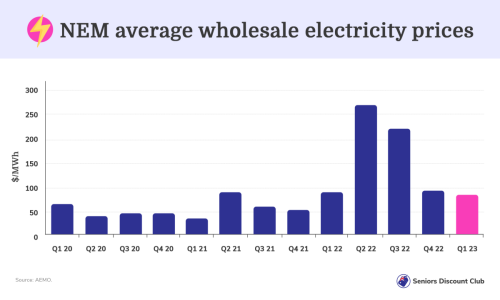Why are your power bills increasing when wholesale electricity prices have plummeted by 59 per cent?
- Replies 13
Have you ever wondered why your power bills keep increasing, even though wholesale electricity prices have reportedly fallen by 59 per cent in the past year? It's a puzzling contradiction that many households are facing.
The figures provided by the Australian Energy Market Operator (AEMO) shed some light on this issue. They revealed that wholesale electricity prices dropped significantly to $108 per megawatt hour in the June quarter, compared to $264 per megawatt hour the previous year.
So, you would assume the lower wholesale prices should have translated into lower bills for consumers.
However, the reality is different. Despite the decrease in wholesale prices, retail price rises were authorised to take effect from July 1, leading to customers in some states paying between 20 to 30 per cent more on their power bills. This is where the confusion lies for many Aussies.

Energy Analyst Tony Wood from the Grattan Institute explained that the recent increase in household power bills is actually a delayed response to the wholesale price rises that occurred last year.
In other words, while wholesale prices have since gone down, the retail prices haven't immediately reflected that change. Instead, there was a lag in passing this on to consumers.
According to Mr Wood, 'This report is all about wholesale prices, and that's the people we buy the electricity from, the retailers, they buy their electricity from the generators through the market, and AEMO operates the market.'
Unfortunately, this means retailers have to manage the fluctuating wholesale costs, some of which led to a few retailers going out of business last year when prices skyrocketed, and they couldn't instantaneously adjust their prices.
So, this current hike in prices is essentially to recover costs that were incurred.
'So what happens is that as things settle down, we see all these costs were incurred,' Mr Wood went on to say.
According to Mr Westerman, the Chief Executive of AEMO, the decrease in wholesale electricity prices is due to three factors.
He explained, 'The first is that coal-fired power stations, which still supply about 60 per cent of Australia's energy, are down because coal prices are down. The second thing is that we've had more coal plant availability, so it's been there when we need it.'
'The third is that we've seen more and more renewables come into the system, and those renewables, as we know, really do push prices down.'
Despite experiencing a year-on-year decrease in the wholesale electricity price, there was an unexpected 31 per cent increase during the second quarter of this year. This surge amounted to a $25 per megawatt-hour increase, making it the second-highest wholesale price spike ever recorded for a June quarter.
The report highlights that the rise in prices was influenced by a higher occurrence of 'high-price events' compared to the first quarter. These events were primarily driven by colder weather conditions, lower wind levels, and transmission restrictions caused by outages.
But what does this mean for those facing these hiked power bills?
While annual wholesale electricity prices have indeed decreased, unfortunately, this drop is not expected to result in cost savings for individuals and families when receiving winter power bills in the upcoming months.
This is because the wholesale electricity market operates on a different timeline than the retail market. It operates a year in advance, meaning any changes in wholesale prices take time to be reflected in the bills consumers receive.
Therefore, the current decline in wholesale prices may be a delayed correction that won't immediately impact the costs paid by households in the short term.
As Mr Wood explained, 'It's just a horrible coincidence. What we should see this time next year is the implications of lower costs then being reflected in, hopefully, a reduction in wholesale prices.'
Mr Westerman stated that the lower wholesale prices would not affect retail bills in the next 12 months because the Australian Energy Regulator has locked in the default market offer for the present financial year.
He hinted at a more hopeful future for energy prices, stating, 'What we're focused on is the wholesale energy component and how we drive that down over time, and the answer to that is firmed renewable energy with transmission.'

As the new financial year begins, many people are facing higher power bill costs due to a significant increase in electricity prices, with some states experiencing up to a 25 per cent rise. Recognising this issue, the federal government took action by introducing the Energy Bill Relief Fund.
To ensure that the assistance reaches those in need, states and territories engaged in negotiations with the federal government to determine how the rebates from the Energy Bill Relief Fund would be distributed among households and small businesses.
Apart from the Energy Bill Relief Fund, various states and territories also provide additional rebates and concessions to support individuals and businesses struggling to manage their power bills.
To find out if you are eligible for energy rebates in your state, simply click on the respective state below:
So, it appears that although we're seeing a decrease in wholesale energy prices now, we must wait for a while until we see the benefits trickle down to us. We anticipate that as Australia shifts towards renewable energy sources, electricity costs will likely be less volatile.
Once again, patience is the name of the game—particularly if we're to weather the storm of fluctuating energy prices! So, members, what are your opinions on this topic? How are you managing your energy bills lately? If you have any money-saving tips or advice to share, please feel free to leave a comment below!
The figures provided by the Australian Energy Market Operator (AEMO) shed some light on this issue. They revealed that wholesale electricity prices dropped significantly to $108 per megawatt hour in the June quarter, compared to $264 per megawatt hour the previous year.
So, you would assume the lower wholesale prices should have translated into lower bills for consumers.
However, the reality is different. Despite the decrease in wholesale prices, retail price rises were authorised to take effect from July 1, leading to customers in some states paying between 20 to 30 per cent more on their power bills. This is where the confusion lies for many Aussies.

Power bills for households increased by 20 to 30 per cent in some states on July 1. Credit: Shutterstock.
Energy Analyst Tony Wood from the Grattan Institute explained that the recent increase in household power bills is actually a delayed response to the wholesale price rises that occurred last year.
In other words, while wholesale prices have since gone down, the retail prices haven't immediately reflected that change. Instead, there was a lag in passing this on to consumers.
According to Mr Wood, 'This report is all about wholesale prices, and that's the people we buy the electricity from, the retailers, they buy their electricity from the generators through the market, and AEMO operates the market.'
Unfortunately, this means retailers have to manage the fluctuating wholesale costs, some of which led to a few retailers going out of business last year when prices skyrocketed, and they couldn't instantaneously adjust their prices.
So, this current hike in prices is essentially to recover costs that were incurred.
'So what happens is that as things settle down, we see all these costs were incurred,' Mr Wood went on to say.
According to Mr Westerman, the Chief Executive of AEMO, the decrease in wholesale electricity prices is due to three factors.
He explained, 'The first is that coal-fired power stations, which still supply about 60 per cent of Australia's energy, are down because coal prices are down. The second thing is that we've had more coal plant availability, so it's been there when we need it.'
'The third is that we've seen more and more renewables come into the system, and those renewables, as we know, really do push prices down.'
Despite experiencing a year-on-year decrease in the wholesale electricity price, there was an unexpected 31 per cent increase during the second quarter of this year. This surge amounted to a $25 per megawatt-hour increase, making it the second-highest wholesale price spike ever recorded for a June quarter.
The report highlights that the rise in prices was influenced by a higher occurrence of 'high-price events' compared to the first quarter. These events were primarily driven by colder weather conditions, lower wind levels, and transmission restrictions caused by outages.
But what does this mean for those facing these hiked power bills?
While annual wholesale electricity prices have indeed decreased, unfortunately, this drop is not expected to result in cost savings for individuals and families when receiving winter power bills in the upcoming months.
This is because the wholesale electricity market operates on a different timeline than the retail market. It operates a year in advance, meaning any changes in wholesale prices take time to be reflected in the bills consumers receive.
Therefore, the current decline in wholesale prices may be a delayed correction that won't immediately impact the costs paid by households in the short term.
As Mr Wood explained, 'It's just a horrible coincidence. What we should see this time next year is the implications of lower costs then being reflected in, hopefully, a reduction in wholesale prices.'
Mr Westerman stated that the lower wholesale prices would not affect retail bills in the next 12 months because the Australian Energy Regulator has locked in the default market offer for the present financial year.
He hinted at a more hopeful future for energy prices, stating, 'What we're focused on is the wholesale energy component and how we drive that down over time, and the answer to that is firmed renewable energy with transmission.'
Key Takeaways
- Wholesale power prices have dramatically fallen by 59 per cent in the past year in stark contrast to retail prices, which have increased by up to 30 per cent in eastern Australia.
- Despite a decrease in wholesale electricity prices, the spike in retail prices is seen as a delayed reaction to the wholesale price rises from last year.
- The wholesale electricity market operates a year in advance of the retail market, meaning any decrease in wholesale prices will not be reflected in retail bills immediately.
- Efforts are being made to shift towards renewable energy sources, which are expected to lead to less volatility in electricity prices and decouple the market from international commodity prices.
As the new financial year begins, many people are facing higher power bill costs due to a significant increase in electricity prices, with some states experiencing up to a 25 per cent rise. Recognising this issue, the federal government took action by introducing the Energy Bill Relief Fund.
To ensure that the assistance reaches those in need, states and territories engaged in negotiations with the federal government to determine how the rebates from the Energy Bill Relief Fund would be distributed among households and small businesses.
Apart from the Energy Bill Relief Fund, various states and territories also provide additional rebates and concessions to support individuals and businesses struggling to manage their power bills.
To find out if you are eligible for energy rebates in your state, simply click on the respective state below:
- Australian Capital Territory
- Queensland
- New South Wales
- Northern Territory
- South Australia
- Tasmania
- Western Australia
- Victoria
So, it appears that although we're seeing a decrease in wholesale energy prices now, we must wait for a while until we see the benefits trickle down to us. We anticipate that as Australia shifts towards renewable energy sources, electricity costs will likely be less volatile.
Once again, patience is the name of the game—particularly if we're to weather the storm of fluctuating energy prices! So, members, what are your opinions on this topic? How are you managing your energy bills lately? If you have any money-saving tips or advice to share, please feel free to leave a comment below!









